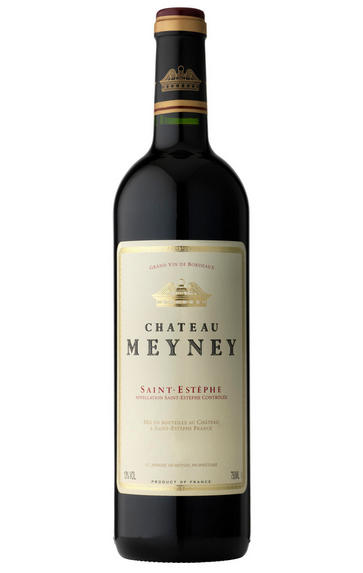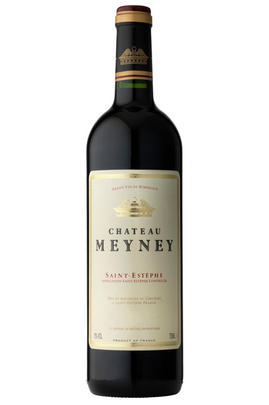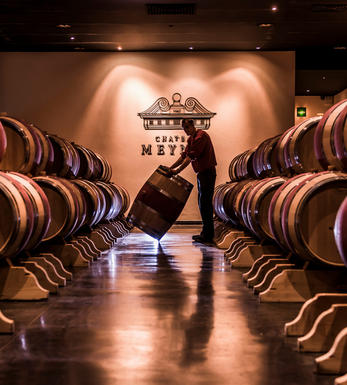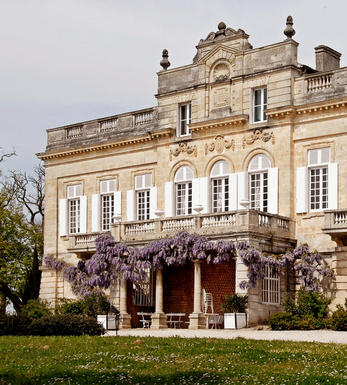
2016 Château Meyney, St Estèphe, Bordeaux

Critics reviews
James Suckling, JamesSuckling.com (February 2019)
Jane Anson, Decanter (April 2017)
About this WINE

Château Meyney
Château Meyney occupies a prime position in St Estèphe, with a single 51-hectare parcel of vines on a sloping rise next to Ch. Montrose and overlooking the Gironde estuary.
Ch. Meyney also benefits from a distinctive array of soil types which together provide ideal conditions for Cabernet Sauvignon (55%), Merlot (30%) and a generous share of Petit Verdot (15%) – this latter giving the wines their attractive, spicy signature.
In her book Inside Bordeaux, Jane Anson writes that she considers Ch. Meyney to be worthy of fifth growth classification by today’s standards.
Vines were planted at the site of Ch. Meyney in 1662, making it one of the oldest vineyards in the Médoc. Originally part of a convent, it has had only three owners since then, the latest being CA Grands Crus, a subsidiary of the Crédit Agricole Group.
They purchased Meyney in 2004 along with Ch. Grand-Puy Ducasse and a number of others. Anne Le Naour came in as Technical Director, and valuable improvements were made in both the vineyard and the cellars.
Ch. Meyney produces a second wine, Prieur de Meyney.
Vines are planted on a favourable sloping rise composed of gravel, sand, limestone and a deep layer of blue clay, the latter principally planted with Merlot and Petit Verdot. Being near the estuary, the vineyard is largely protected from frosts. The average age of the vines is 35-40 years, with fruit from the younger vines typically used for the second wine.
Grapes are sorted twice, first in the vineyard and again in the winery, and then fermented in vats. Larger vats have been replaced with a range of smaller sizes to enable more individual plots to be vinified separately. The grand vin is aged for 15 months in 30% new French oak barrels; the second wine, made with fruit from younger vines, typically sees 10–15% new oak.

Saint-Estèphe
Saint-Estèphe is the northernmost of the most important communes of the Médoc and borders Pauillac on its southernmost border, with only a gully and stream separates it from Ch. Lafite. To the north lies the Bas-Médoc.
Saint-Estèphe is defined by the depth of its gravel, which is ubiquitous but of varying depths and occasionally very shallow, when clay predominates. This keeps the soil cooler and wetter than its counterparts so that the wines can appear fresh in lighter vintages, but superbly successful in hot, dry years.
The best châteaux in the south of the commune have the deepest soil and the thickest gravel. Cos d'Estournel has an exceptional terroir with its vineyards being located on a south-facing ridge of gravel with excellent drainage.
Saint-Estèphe is the least gravelly of main Médoc communes and in the north of the commune the vineyards are heavier and more clay-based leading to a rustic style of wine being produced.
The wines can appear austere in youth with a discernable ferric note at some châteaux, but the best typically display good depth of colour, pronounced acidity an tannins in youth and are exceptionally long-lived. At their best, they are the equal of almost any Bordeaux. The well-regarded St Estèphe co-operative controls the production of about half the appellation.
Recommended Châteaux
Cos (Ch. Cos d'Estournel), Ch. Montrose, Ch. Calon-Ségur, Ch. Lafon-Rochet, Ch. Les Ormes de Pez, Ch. Beau-Site, Ch. Cos Labory, Ch. Phélan-Ségur

Cabernet Sauvignon Blend
Cabernet Sauvignon lends itself particularly well in blends with Merlot. This is actually the archetypal Bordeaux blend, though in different proportions in the sub-regions and sometimes topped up with Cabernet Franc, Malbec, and Petit Verdot.
In the Médoc and Graves the percentage of Cabernet Sauvignon in the blend can range from 95% (Mouton-Rothschild) to as low as 40%. It is particularly suited to the dry, warm, free- draining, gravel-rich soils and is responsible for the redolent cassis characteristics as well as the depth of colour, tannic structure and pronounced acidity of Médoc wines. However 100% Cabernet Sauvignon wines can be slightly hollow-tasting in the middle palate and Merlot with its generous, fleshy fruit flavours acts as a perfect foil by filling in this cavity.
In St-Emilion and Pomerol, the blends are Merlot dominated as Cabernet Sauvignon can struggle to ripen there - when it is included, it adds structure and body to the wine. Sassicaia is the most famous Bordeaux blend in Italy and has spawned many imitations, whereby the blend is now firmly established in the New World and particularly in California and Australia.


Buying options
Add to wishlist
Description
St Estèphe was one of the best communes of the 2016 vintage and this example certainly doesn't disappoint. It has great intensity and the 2016 is generous with pleasing aromatics of black briar fruit, coffee notes and spices. It has unctuous bright fruit with a polished texture. Reliably old school.
Blend: Cabernet Sauvignon 67%, Merlot 25%, Cabernet Franc 6%, Petit Verdot 2%
wine at a glance
Delivery and quality guarantee